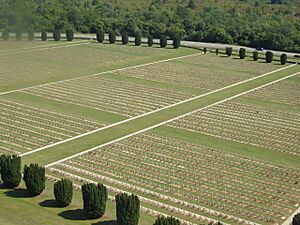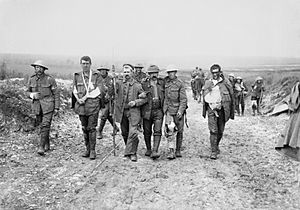World War I casualties facts for kids
World War I was one of the deadliest conflicts in human history. Around 40 million people were affected. This includes about 15 to 22 million deaths. Also, about 23 million military people were wounded.
The total number of deaths includes 9 to 11 million soldiers. About 6 to 13 million civilians also died. The Triple Entente, also known as the Allies, lost about 6 million soldiers. The Central Powers lost about 4 million soldiers. At least 2 million people died from diseases. Another 6 million went missing and were thought to be dead. This article shares numbers about those who died or were injured. These numbers come from official reports.
About two-thirds of soldiers died in battle during World War I. This was different from wars in the 1800s. Back then, most deaths were from disease. Still, diseases like the 1918 flu pandemic caused many deaths. Being a prisoner of war also led to deaths. These causes made up about one-third of all military deaths.
Contents
Understanding Casualty Numbers

The numbers for World War I casualties can vary a lot. Estimates for total deaths range from 9 million to over 15 million. Official reports list military deaths from all causes. This includes 7 to 8 million deaths from combat. Another 2 to 3 million military deaths were from accidents, disease, or being a prisoner of war.
Governments like the United States and Great Britain published reports. These reports from the 1920s are the main source for these numbers. This article uses statistics from these official reports. It also includes figures from France, Italy, Belgium, Germany, Austria, and Russia.
More recently, the Commonwealth War Graves Commission (CWGC) updated UK military numbers. They now include support staff and civilians from Africa, the Middle East, and China. These people helped with supplies and services. Their deaths were not always counted before. However, British workers from the British Isles were included in earlier reports.
Each country counted casualties differently. So, comparing numbers directly can be tricky. Experts say estimating civilian deaths is hard. One accepted number for non-combatant deaths is 6.5 million.
How Many People Died in World War I?
This section shows how many people died or were wounded. It focuses on countries as they were between 1914 and 1918. If a country's death count is debated, a range of numbers is given.
| Nation | Population (millions) | Total military deaths | Civilian deaths | Total deaths | Deaths as % of population | Military wounded |
|---|---|---|---|---|---|---|
| Allies and their friends | ||||||
| 5.0 | 59,330 to 62,149 |
59,330 to 62,149 |
1.2% to 1.2% |
152,171 | ||
| 7.2 | 56,639 to 64,996 |
1,963 | 58,639 to 66,996 |
0.8% to 0.9% |
149,732 | |
| 315.1 | 64,449 to 73,905 |
64,449 to 73,905 |
0% to 0% |
69,214 | ||
| 1.1 | 16,711 to 18,060 |
16,711 to 18,060 |
1.5% to 1.6% |
41,317 | ||
| 0.2 | 1,204 to 1,570 |
1,204 to 1,570 |
0.6% to 0.8% |
2,314 | ||
| 6.0 | 7,121 to 9,726 |
7,121 to 9,726 |
0.1% to 0.2% |
12,029 | ||
| 45.4 | 887,858 | 16,829 to 400,000 | 867,829 to 1,011,687 |
1.9% to 2.2% |
1,675,000 | |
|
380.0 | 949,454 to 1,118,264 |
125,829 | 1,077,283 to 1,244,093 |
0.3% to 0.3% |
2,101,077 |
| 7.4 | 38,170 to 58,637 |
85,700 | 123,870 to 144,337 |
1.7% to 2% |
44,686 | |
| 39.6 | 1,357,000 to 1,397,800 |
340,000 to 640,000 | 1,697,000 to 1,737,800 |
4.3% to 4.4% |
4,266,000 | |
| 4.8 | 5,000 to 26,000 |
150,000 | 155,000 to 176,000 |
3.2% to 3.7% |
21,000 | |
| 35.6 | 460,000 to 709,000 |
335,400 to 592,400 | 1,052,400 to 1,301,400 |
3% to 3.7% |
947,000 to 1,050,000 | |
| 53.6 | 300 to 4,661 |
300 to 4,661 |
0% to 0% |
907 | ||
| 0.5 | 3,000 to 13,325 |
3,000 to 13,325 |
0.6% to 2.7% |
10,000 | ||
| 6.0 | 7,222 | 82,013 | 89,235 | 1.5% | 13,751 | |
| 7.5 | 250,000 to 335,706 |
330,000 | 580,000 to 665,706 |
7.7% to 8.9% |
120,000 | |
| 175.1 | 1,700,000 to 2,254,369 |
1,140,000 | 2,840,000 to 3,394,369 |
1.6% to 1.9% | 3,749,000 to 4,950,000 |
|
| 4.5 | 300,000 to 450,000 |
450,000 to 800,000 |
750,000 to 1,250,000 |
16.7% to 27.8% |
133,148 | |
| 92.0 | 116,708 | 757 | 117,466 | 0.1% | 204,002 | |
|
806.6 | 5,186,854 to 6,433,692 |
4,046,699 to 4,396,699 |
9,235,553 to 10,080,391 |
1.1% to 1.2% |
11,611,271 to 12,812,271 |
| Central Powers | ||||||
| 51.4 | 1,200,000 to 1,494,200 |
587,000 | 1,787,000 to 2,081,200 |
3.5% to 4% |
3,620,000 | |
| 4.5 | 87,500 | 100,000 | 187,500 | 3.4% | 152,390 | |
| 64.9 | 2,037,000 | 300,720 to 763,720 | 2,198,420 to 2,800,720 |
3.4% to 4.3% |
4,215,662 | |
| 21.3 | 325,000 to 771,844 |
2,500,000 | 2,825,000 to 3,271,844 |
13.3% to 15.4% |
400,000 to 763,753 |
|
|
142.1 | 3,386,200 to 4,390,544 |
2,987,720 to 3,363,720 |
6,997,920 to 8,341,264 |
4.9% to 5.9% |
8,388,052 to 8,751,805 |
| Neutral nations | ||||||
| 2.8 | 700 | 700 | 0% | — | ||
| 0.3 | 2,800 | See footnote | ||||
| 2.4 | 1,180 | 1,180 | 0.1% | — | ||
| 10.5 | 2,000,000 | 2,000,000 | 19% | — | ||
| 5.6 | 800 | 800 | 0% | — | ||
| 0.7 to 0.8 | 70,000 | 70,000 | 8.75% to 10% | — | ||
| 0.0087 | 4 | 4 | 0.05% | — | ||
| Grand total | 959.7 | 8,573,058 to 10,824,240 |
7,661,000 to 10,460,419 |
15,000,000 to 22,000,000 | 1.7% to 2.3% |
22,101,100 to 23,665,873 |
The population numbers come from Philip J. Haythornthwaite's book, The World War One Source Book.
Casualties in New Borders (After 1924)
World War I involved large empires with many different groups of people. These included Great Britain, France, Germany, Russia, Austria-Hungary, and Turkey. Many people from these areas were forced to join the military. The numbers for countries with new borders are also included in the table above.
These numbers for countries with new borders are rough guesses. They come from a Russian historian named Vadim Erlikman. He published them in 2004. The Oxford History of World War One notes that in Africa, the war caused food shortages and diseases. These problems killed hundreds of thousands of people and animals.
A Russian historian estimated deaths in modern-day Austria. About 175,000 people died. This includes 120,000 soldiers with Austria-Hungary. Another 30,000 prisoners of war died. About 25,000 civilians died from hunger and sickness.
A Russian historian estimated deaths in modern-day Belarus. About 130,000 people died. This includes 70,000 soldiers with Russia. About 60,000 civilians also died.
A Russian historian estimated deaths in modern-day Ukraine. About 590,000 people died. This includes 450,000 soldiers. About 140,000 civilians also died.
The Belgian Congo was part of Belgium during the war. A Russian historian estimated 155,000 deaths there.
Czechoslovakia was part of Austria-Hungary. A Russian historian estimated 185,000 deaths in its 1991 borders. This includes 110,000 soldiers with Austria-Hungary. Another 45,000 prisoners of war died. About 30,000 civilians died from hunger and sickness.
Estonia was part of the Russian Empire. About 100,000 Estonians served in the Russian Army. Around 10,000 of them died.
Finland was a self-governing part of the Russian Empire. Finns did not have to join the Russian Army. About 800 Finns volunteered. Around 317 Finns died between 1914 and 1917.
A Russian historian estimated military deaths in French colonies. These numbers do not include civilian deaths. Total civilian deaths in Africa could be up to 750,000.
 Algeria (French Algeria): 26,000
Algeria (French Algeria): 26,000 Vietnam (French Indochina): 12,000
Vietnam (French Indochina): 12,000 Mali (French West Africa): 10,000
Mali (French West Africa): 10,000 Morocco (French protectorate of Morocco): 8,000
Morocco (French protectorate of Morocco): 8,000 Senegal (French West Africa): 6,000
Senegal (French West Africa): 6,000 Guinea (French West Africa): 2,500
Guinea (French West Africa): 2,500 Madagascar: 2,500 military
Madagascar: 2,500 military Benin (French West Africa): 2,000
Benin (French West Africa): 2,000 Burkina Faso (French West Africa): 2,000
Burkina Faso (French West Africa): 2,000 Republic of the Congo (French Equatorial Africa): 2,000
Republic of the Congo (French Equatorial Africa): 2,000 Côte d'Ivoire (French West Africa): 2,000
Côte d'Ivoire (French West Africa): 2,000 Tunisia (French Tunisia): 2,000
Tunisia (French Tunisia): 2,000 Chad (French Equatorial Africa): 1,500
Chad (French Equatorial Africa): 1,500 Central African Republic (French Ubangi-Shari): 1,000
Central African Republic (French Ubangi-Shari): 1,000 Niger (French West Africa): 1,000
Niger (French West Africa): 1,000 Gabon (French Equatorial Africa): 500
Gabon (French Equatorial Africa): 500 India (French Establishments in India): 195
India (French Establishments in India): 195
Total: 82,000
Georgia was part of the Russian Empire. About 150,000 Georgians served in the Russian Army. Around 10,000 of them died.
A Russian historian estimated military deaths in German colonies. These numbers do not include civilian deaths.
 Tanzania (German East Africa): 20,000
Tanzania (German East Africa): 20,000 Namibia (German South-West Africa): 1,000
Namibia (German South-West Africa): 1,000 Cameroon (Kamerun): 5,000 military and 50,000 civilian
Cameroon (Kamerun): 5,000 military and 50,000 civilian Togo (German Togoland): 2,000
Togo (German Togoland): 2,000 Rwanda (German East Africa): 15,000
Rwanda (German East Africa): 15,000
Total: 48,000
A Russian historian estimated deaths in modern-day Hungary. About 385,000 people died. This includes 270,000 soldiers with Austria-Hungary. Another 70,000 prisoners of war died. About 45,000 civilians died from hunger and sickness.
Ireland was part of the United Kingdom during the war. About 206,000 Irishmen served in British forces. At least 30,986 Irish-born soldiers died. Many Irish also served in Australian and Canadian forces.
A Russian historian estimated 52,000 deaths in Portuguese Mozambique.
Poland was controlled by Germany, Austria-Hungary, and Russia. A 2005 study estimated 3,376,800 Poles were forced into these armies. Another 300,000 were forced into labor. About 1.6 to 1.8 million Poles were moved from war zones. One estimate says 1,080,000 Poles died. Another estimate says 640,000 Poles died. This includes 270,000 soldiers, 120,000 civilians from fighting, and 250,000 from hunger and disease.
Transylvania was part of Austria-Hungary. A Russian historian estimated deaths in modern-day Romania. About 748,000 people died. This includes 220,000 soldiers with Romania. Another 150,000 soldiers with Austria-Hungary died. About 48,000 prisoners of war died. Civilian deaths included 200,000 from hunger and disease, 120,000 from fighting, and 10,000 in Austrian prisons.
Britain recruited workers from India, China, Africa, and Egypt. These workers helped with supplies. About 44,911 recruited workers died in East Africa. Nearly 2,000 Chinese Labour Corps workers are buried with British soldiers in France.
A Russian historian estimated military deaths in British colonies:
 Ghana (Gold Coast): 1,200
Ghana (Gold Coast): 1,200 Kenya (British East Africa): 2,000
Kenya (British East Africa): 2,000 Malawi (Nyasaland): 3,000
Malawi (Nyasaland): 3,000 Nigeria (British West Africa): 5,000
Nigeria (British West Africa): 5,000 Sierra Leone (British West Africa): 1,000
Sierra Leone (British West Africa): 1,000 Uganda (Uganda Protectorate): 1,500
Uganda (Uganda Protectorate): 1,500 Zambia (Northern Rhodesia): 3,000
Zambia (Northern Rhodesia): 3,000 Zimbabwe (Southern Rhodesia): About 700 European soldiers died. 31 African soldiers died in action. 142 died from other causes.
Zimbabwe (Southern Rhodesia): About 700 European soldiers died. 31 African soldiers died in action. 142 died from other causes.
Total: 18,000
These numbers are for Yugoslavia within its 1991 borders. Slovenia, Croatia, Bosnia, and Vojvodina were part of Austria-Hungary. Serbia and Montenegro were independent. A historian named Vladimir Dedijer said 1.9 million people died in Yugoslav lands. 43% of these were from Serbia.
A Russian historian estimated deaths in Yugoslavia's 1991 borders. About 996,000 people died. This includes 260,000 soldiers with Serbia. Another 80,000 with Austria-Hungary and 13,000 with Montenegro died. About 93,000 prisoners of war died. Civilian deaths included 400,000 from hunger and disease. 120,000 died in military operations. 30,000 died in Austrian prisons or were executed.
During World War I, Nepal sent over 20,000 volunteer troops to India. They helped free up British and Indian soldiers. Nepal also helped recruit more Gurkha soldiers for Britain. Many Nepalese served in non-fighting roles. They also fought in France, Turkey, Palestine, and Mesopotamia. Of over 200,000 Nepalese who served, about 20,000 Gurkha casualties are included with the British Indian Army numbers.
See also
- List of nurses who died in World War I
- Thankful Villages – villages in England and Wales that lost no men in World War I
- World War I memorials
- World War II casualties




